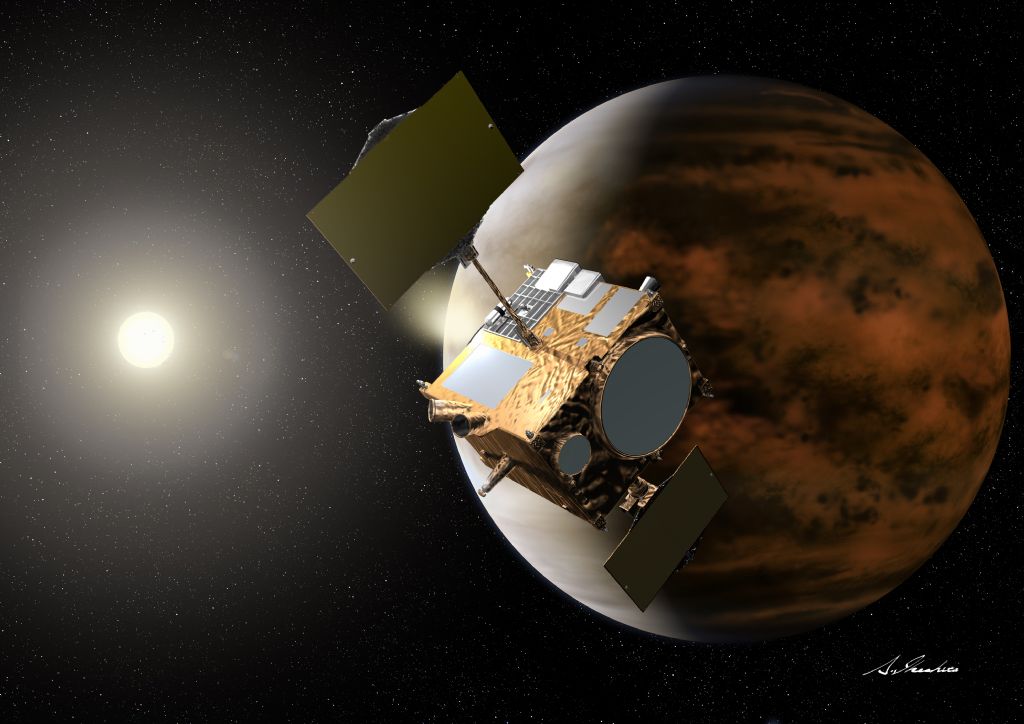Japanese Spacecraft to Attempt Venus Comeback in December

A Japanese spacecraft will get a second chance to orbit Venus this December, five years after zooming past the planet on its first try.
The Akatsuki Venus probe was supposed to begin circling Earth's hellishly hot sister planet in December 2010, but the craft's main engine failed during the crucial orbital-insertion burn.
Akatsuki has been orbiting the sun ever since, waiting for another shot at Venus. And now officials at the Japan Aerospace Exploration Agency (JAXA) have settled on a date for the comeback attempt: Dec. 7. [Photos of Venus, the Mysterious Planet Next Door]
Akatsuki's main engine is dead, so the probe will try to achieve orbit on that date using its smaller attitude-control thrusters, mission team members have said. If the maneuver works, Akatsuki will slip into a highly elliptical orbit that completes one lap around Venus every eight to nine days. (The original mission plan called for a 30-hour orbital period.)
Akatsuki, whose name means "dawn" in Japanese, will then study Venus' atmosphere with a variety of instruments, gathering data about the planet's clouds, air circulation patterns and other characteristics.
"When flying further away from Venus, or about 10 times the radius of Venus from the planet, the Akatsuki will continuously observe Venus as a whole to understand its clouds, deep atmosphere and surface conditions," JAXA officials wrote in a mission update in February. "When flying closer to Venus, or less than 10 times the radius of Venus, the orbiter will conduct close-up observations to clarify cloud convection, the distribution of minute undulatory motions and their changes."
The $300 million Akatsuki probe launched in May 2010 on a mission to help researchers better understand how Venus, which was similar to Earth in the solar system's early days, ended up so hot and seemingly inhospitable to life.
Breaking space news, the latest updates on rocket launches, skywatching events and more!
Akatsuki blasted off on the same rocket as JAXA's IKAROS (Interplanetary Kite-craft Accelerated by Radiation Of the Sun) spacecraft, which became the first probe ever to travel through deep space using a solar sail.
The Akatsuki mission marks Japan's second attempt to explore another planet with a robotic space probe. The nation's first interplanetary spacecraft, the Nozomi Mars orbiter, also experienced problems after its launch, which occurred in 1998.
A valve malfunction caused a significant amount of Nozomi's fuel to be lost, scuttling a planned 1999 Mars arrival. JAXA then worked to get Nozomi into orbit around the Red Planet in December 2003 but was unable to pull it off.
Follow Mike Wall on Twitter @michaeldwall and Google+. Follow us @Spacedotcom, Facebook or Google+. Originally published on Space.com.

Michael Wall is a Senior Space Writer with Space.com and joined the team in 2010. He primarily covers exoplanets, spaceflight and military space, but has been known to dabble in the space art beat. His book about the search for alien life, "Out There," was published on Nov. 13, 2018. Before becoming a science writer, Michael worked as a herpetologist and wildlife biologist. He has a Ph.D. in evolutionary biology from the University of Sydney, Australia, a bachelor's degree from the University of Arizona, and a graduate certificate in science writing from the University of California, Santa Cruz. To find out what his latest project is, you can follow Michael on Twitter.
